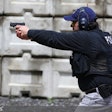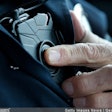You've heard my mantra before: What gets you hurt, gets you sued! As trainers, we focus a lot on liability issues—or at least our departments do—and that means we're always talking about getting sued. But, as trainers, we also know that the main thing is officer safety. Anything we do in the classroom, on the range, or on the mat, must have a strong officer safety thread running through it.
So, how do we reconcile these two overwhelming concerns—safety and liability?
Simple: what gets you hurt also gets you sued.
Actually, it's not simple at all, but it's still true.
If you look at the ways we get hurt as officers on the street, there are two primary things that get us: motor vehicles and forcible arrests. Any analysis of officer injuries leads to that clear focus: motor vehicles and forcible arrests.
Then consider how and why we get sued. Remember, I'm not talking here about all of the lawsuits against agencies, their members, and their municipalities; I'm focusing on what gets us sued as the result of street policing. That's the unpredictable stuff, because it's so much in the hands of the other guy. Things that lead to litigation arising from administrative practices and the like are a lot more controllable and predictable (So why do they happen anyway, you ask? That's another column!).
And when you look at those things that get us sued as a result of street policing, it's again pretty clear that we're talking about motor vehicles and forcible arrests. We can also throw in things like false arrest, illegal searches, and the like, but keep in mind that those are frequently going to be closely associated with a forcible arrest.
So, in reality, as street coppers, we only have two big things to worry about, in order to reduce the potential for injuries and lawsuits: motor vehicles and forcible arrests. If we could just manage those two things better, we could begin to solve two of our biggest worries, officer injuries and lawsuits.
If it seems like I keep repeating those phrases over and over—motor vehicles and forcible arrests, officer injuries and lawsuits, and what gets you hurt also gets you sued—it's because they represent one of the seldom discussed but absolute truths about law enforcement today, and here it is:
There is no way to separate liability and officer safety. They are inexorably linked, interwoven, and interlocked. Here's how:
Lawsuits arising from street police work typically occur because we have injured someone. Sometimes that injury is the result of an intentional act, like use of force, and sometimes it's "accidental," like in a car crash. But the injury or death of another person at the hands of a law enforcement officer will give rise to a close examination of the officer's actions, and probably will lead to litigation.
The times that we are most likely to injure someone are the same times that we are most likely to get injured ourselves. When we make an arrest, struggle with a suspect, or otherwise use force, there is always a very real danger that we can get injured. When we injure someone in a car crash, there's also the chance that we will be injured, as well.
See that? The same incidents that cause us to injure others also carry a significant threat of injury to the involved officers.
What can we do about that? We can work safer. If you drive safer, you're less likely to injure another person in a crash. If you manage your enforcement encounters better, either through improved tactics, enhanced verbal and non-verbal skills, or properly executed non-lethal techniques, you are less likely to injure your suspect.
Here's the dirty little secret about what we do. No matter how much we focus on liability, unless we also focus on safety, we'll never be successful.
We're talking about managing risk, plain and simple. The more we manage our risk of getting hurt, the less likely we are to hurt someone else.
But, there's a trap. We in law enforcement often get so caught up in trying to avoid risk that we fail to properly manage it. And the fact is that you cannot avoid all risk. Things happen, sometimes despite your best efforts. All you can do is avoid those things that are avoidable, and manage the potential damage from those things that aren't.
So, you wear a vest. Doesn't keep you from getting shot, but it reduces the damage if you are. Same thing with an automobile safety belt, or a motorcycle helmet. You train thoroughly with your non-lethal weapons, and you practice good tactical awareness, and you wait for backup, and you communicate well, and you learn to manage non-verbals (both yours and your suspect's). By doing all of these things, you avoid some of the risk, and you reduce the potential for damage if it does hit the fan.
Even if you have to hurt someone to take them into custody, you try to do it in such a way that they are not seriously injured. If they escalate, then you do what needs to be done, and your skills reduce the likelihood for you to be injured during the incident.
As trainers, we have to guard against the tendency to use a "scared straight" approach with our people. The more we preach about liability, the more we run the risk of instilling fear and self-doubt in our officers. The message needs to be one of safety and success, thinking things through, and making good decisions that will keep everyone involved in an incident as safe as possible, while still getting the job done.
The trainer is the person in your department who is in the best position to make this happen. Administrative matters will be cast as they must be for legal defensibility. Tactical issues will be addressed by officers and supervisors in whatever way they need to be in order that our people stay as safe as they can when going about their jobs. The role of the trainer is to meld those two focused concerns into one message for the people that hit the street each day:
What gets you hurt also gets you sued.














